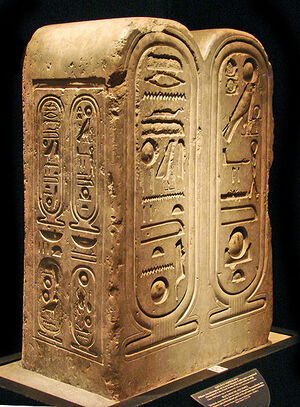Cartouche (nonfiction): Difference between revisions
No edit summary |
|||
| (11 intermediate revisions by the same user not shown) | |||
| Line 1: | Line 1: | ||
[[File:441px-Stela_of_the_Great_temple_of_Aten_at_Akhetaten2008.jpg|thumb|Well preserved stela from the Great temple of Aten from Akhetaten at Tell el-Amarna. The stela bears the cartouche of Akhenaten, Neferkheperure, on its left side. The name of the god Aten is also shown enclosed in a royal cartouche. It is now in the Egyptian Museum of Turin.]]In Egyptian hieroglyphs, a '''cartouche''' (English pronunciation: /kɑːˈtuːʃ/) is an oval with a horizontal line at one end, indicating that the text enclosed is a royal name, coming into use during the beginning of the Fourth Dynasty under Pharaoh Sneferu. | |||
While the cartouche is usually vertical with a horizontal line, it is sometimes horizontal if it makes the name fit better, with a vertical line on the left. | While the cartouche is usually vertical with a horizontal line, it is sometimes horizontal if it makes the name fit better, with a vertical line on the left. | ||
The Ancient Egyptian word for it was | The Ancient Egyptian word for it was shenu, and it was essentially an expanded shen ring. | ||
In | In Demotic, the cartouche was reduced to a pair of brackets and a vertical line. | ||
Of the | Of the five royal titularies it was the ''prenomen'', the ''throne name'', and the "Son of Ra" titulary, the so-called ''nomen'' name given at birth, which were enclosed by a cartouche. | ||
At times amulets were given the form of a cartouche displaying the name of a king and placed in tombs. | |||
Such items are often important to archaeologists for dating the tomb and its contents. | |||
Cartouches were formerly only worn by Pharaohs. | |||
The oval surrounding Pharaoh's name was meant to protect Pharaoh from evil spirits in life and after death. | |||
Egyptians believed that one who had their name recorded somewhere would not disappear after death. | |||
A cartouche attached to a coffin satisfied this requirement. | |||
The cartouche has become a symbol representing good luck and protection from evil. | The cartouche has become a symbol representing good luck and protection from evil. | ||
There were periods in Egyptian history when people refrained from inscribing these amulets with a name, for fear they might fall into somebody's hands conferring power over the bearer of the name. | There were periods in Egyptian history when people refrained from inscribing these amulets with a name, for fear they might fall into somebody's hands conferring power over the bearer of the name. | ||
The term ''cartouche'' was first applied by soldiers who fancied that the symbol they saw so frequently repeated on the pharaonic ruins they encountered resembled a muzzle-loading firearm's paper powder cartridge (''cartouche'' in French). | |||
The term cartouche was first applied by soldiers who fancied that the symbol they saw so frequently repeated on the pharaonic ruins they encountered resembled a muzzle-loading firearm's paper powder cartridge (''cartouche'' in French). | |||
== | == In the News == | ||
<gallery> | |||
File:Woman-mending-net_Utagawa_Kuniyoshi.jpg|Genetic engineer weaving strands of [[metachondria]] into a semi-autonomous fishing net. Note the red cartouche (upper left). | |||
</gallery> | |||
== Fiction cross-reference == | == Fiction cross-reference == | ||
* [[Metachondria]] | |||
* [[Niles Cartouchian]] | * [[Niles Cartouchian]] | ||
== External links | == Nonfiction cross-reference == | ||
* [[Pefsu problem (nonfiction)]] | |||
External links: | |||
* [https://en.wikipedia.org/wiki/Cartouche Cartouche] @ Wikipedia | * [https://en.wikipedia.org/wiki/Cartouche Cartouche] @ Wikipedia | ||
[[Category:Nonfiction (nonfiction)]] | |||
[[Category:Writing (nonfiction)]] | |||
Latest revision as of 10:13, 14 January 2018
In Egyptian hieroglyphs, a cartouche (English pronunciation: /kɑːˈtuːʃ/) is an oval with a horizontal line at one end, indicating that the text enclosed is a royal name, coming into use during the beginning of the Fourth Dynasty under Pharaoh Sneferu.
While the cartouche is usually vertical with a horizontal line, it is sometimes horizontal if it makes the name fit better, with a vertical line on the left.
The Ancient Egyptian word for it was shenu, and it was essentially an expanded shen ring.
In Demotic, the cartouche was reduced to a pair of brackets and a vertical line.
Of the five royal titularies it was the prenomen, the throne name, and the "Son of Ra" titulary, the so-called nomen name given at birth, which were enclosed by a cartouche.
At times amulets were given the form of a cartouche displaying the name of a king and placed in tombs.
Such items are often important to archaeologists for dating the tomb and its contents.
Cartouches were formerly only worn by Pharaohs.
The oval surrounding Pharaoh's name was meant to protect Pharaoh from evil spirits in life and after death.
Egyptians believed that one who had their name recorded somewhere would not disappear after death.
A cartouche attached to a coffin satisfied this requirement.
The cartouche has become a symbol representing good luck and protection from evil.
There were periods in Egyptian history when people refrained from inscribing these amulets with a name, for fear they might fall into somebody's hands conferring power over the bearer of the name.
The term cartouche was first applied by soldiers who fancied that the symbol they saw so frequently repeated on the pharaonic ruins they encountered resembled a muzzle-loading firearm's paper powder cartridge (cartouche in French).
In the News
Genetic engineer weaving strands of metachondria into a semi-autonomous fishing net. Note the red cartouche (upper left).
Fiction cross-reference
Nonfiction cross-reference
External links:
- Cartouche @ Wikipedia

